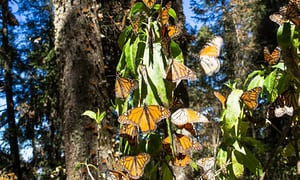Number of natural world heritage sites at serious risk from global warming has doubled in three years, says the IUCN, including the Great Barrier Reef and spectacular karst caves in Europe
 |
| Mount Kilimanjaro - a natural wonder at risk from climate change as its glaciers shrink. Photograph: khanbm52/Getty Images/iStockphoto |
A new report on Monday from the International Union for Conservation of Nature (IUCN) reveals that the number of natural world heritage sites being damaged and at risk from global warming has almost doubled to 62 in the past three years.
Those at high risk include iconic places from the Galapagos Islands to the central Amazon and less well known but equally vibrant and unique sites such as the karst caves of Hungary and Slovakia and the monarch butterfly reserves in Mexico.
 |
| Monarch butterflies in Michoacan state, Mexico. Photograph: Alianza-WWF-Telcel / HANDOUT/EPA |
Other ecosystems being damaged are wetlands, such as the Everglades, where sea level is rising as the ocean warms and salt water is intruding. In the Sundarbans mangrove forest on the delta of the Ganges, Brahmaputra and Meghna rivers on the Bay of Bengal, two islands have already been submerged and a dozen more are threatened. Fiercer storms are also increasing the risk of devastation.
Australia is especially exposed as it has 10 natural heritage sites where climate change damage is rated as high or very high risk, from its Gondwana rainforests to Shark Bay in western Australia and islands such as Fraser and Macquarie.
 |
| Everglades National Park is a national park in Florida. It is the largest subtropical wilderness in the US. Photograph: Robin Hill/Getty Images |
“Protection of world heritage sites is an international responsibility of the same governments that have signed up to the Paris agreement,” said Inger Andersen, IUCN director general. “This report sends them a clear message: climate change acts fast and is not sparing the finest treasures of our planet. This underlines the need for urgent and ambitious national commitments and actions to implement the Paris agreement.”
Climate change is one of a range of factors that mean about a third of the world’s 241 natural heritage sites are being damaged, with invasive alien species being the top threat. Then, after global warming, comes unsustainable tourism, followed by other problems like poaching and construction.
Prince Charles, the UK’s heir to the throne and longtime environmentalist, said: “Climate change is in actual fact becoming regarded as the fastest growing threat, its impacts already visible in many of the sites. This report highlights the incredibly urgent need to expedite the global response to climate change.” A further 55 sites around the world are expected to be harmed by climate change in the future unless warming is curbed.
“Natural world heritage sites also play a crucial role supporting local economies and livelihoods,” said Tim Badman, director of IUCN’s World Heritage Programme. “Their destruction can thus have devastating consequences that go beyond their exceptional beauty and natural value. In Peru’s Huascarán national park, for example, melting glaciers affect [people’s] water supplies.”
The report does include some success stories, showing that the destruction of nature’s most precious sites can be tackled. In Ivory Coast’s Comoé national park, for example, elephant and chimpanzee populations have recovered thanks to better management and international support after the end of conflicts.
But overall, the number of sites with good status has fallen, leaving Andersen to ask: “If we cannot secure the highest quality protection for the world’s most precious natural areas, what will this say about our ability to fulfil our collective commitments towards the planet, including the Paris agreement?”
Links
- The 10 species most at risk from climate change
- Climate change: global reshuffle of wildlife will have huge impacts on humanity
- One in six of world's species faces extinction due to climate change – study
- From Miami to Shanghai: 3C of warming will leave world cities below sea level
- Fossil fuel burning set to hit record high in 2017, scientists warn
- Syria signs Paris climate agreement and leaves US isolated
- The COP23 climate change summit in Bonn and why it matters
- Climate change tipping points are not just symbolic

No comments :
Post a Comment